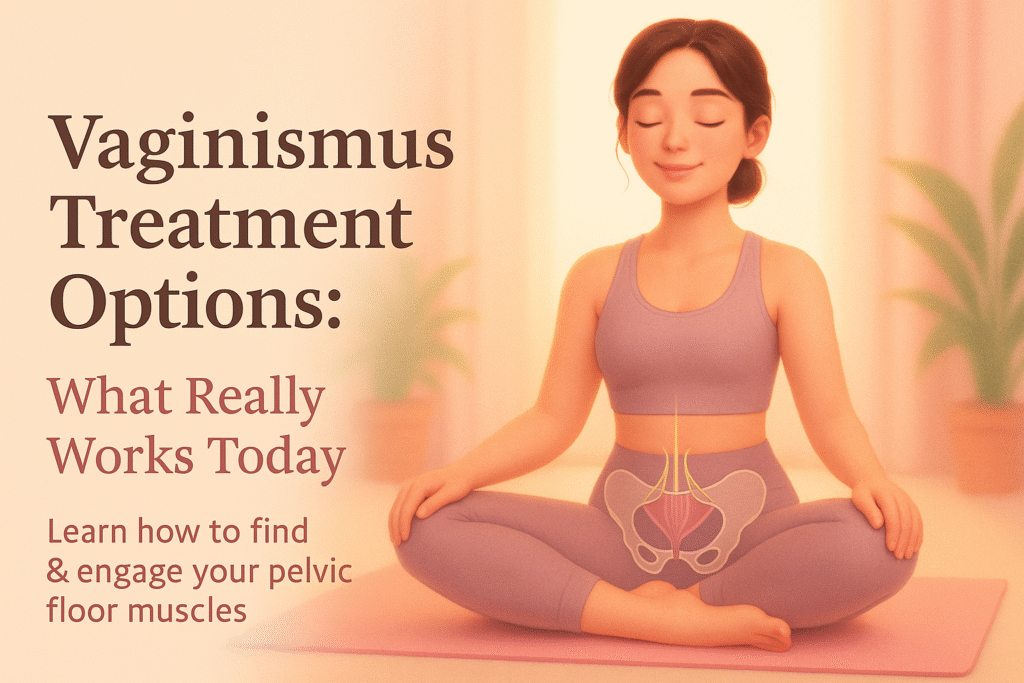
What Is Vaginismus?

Vaginismus is a condition where the vaginal muscles tighten involuntarily during penetration, making sexual intercourse, tampon use, or even gynecological exams painful—or impossible.
It can be primary (present since first attempts at penetration) or secondary (develops later in life).
While the causes vary, treatment is highly effective when tailored to each individual.
Why Early Treatment Matters

Delaying treatment can worsen both physical and emotional symptoms, creating a cycle of fear, pain, and avoidance. The good news? With the right approach, most women fully recover and regain pain-free intimacy.
1. Pelvic Floor Physical Therapy (Most Recommended)

Pelvic floor therapists specialize in teaching you how to relax, strengthen, and control the vaginal muscles.
Typical sessions may include:
- Gentle internal and external muscle assessments
- Biofeedback tools to visualize muscle activity
- Relaxation and stretching techniques
Why it works: Many women with vaginismus unknowingly keep their pelvic floor in a state of tension. Therapy teaches how to release that tension.
2. Vaginal Dilators for Gradual Desensitization

Vaginal dilators are smooth, medical-grade tools used to gently stretch the vaginal muscles.
The process involves:
- Starting with the smallest size
- Using lubrication for comfort
- Practicing regularly for 10–15 minutes
Over time, you progress to larger sizes until penetration becomes pain-free.
Pro Tip: Combine dilator use with deep breathing and pelvic floor relaxation for better results.
3. Cognitive Behavioral Therapy (CBT) & Sex Therapy
When vaginismus is linked to anxiety, trauma, or fear, therapy can be transformative.
CBT helps reframe negative associations, while sex therapy addresses relationship dynamics and sexual confidence.
Best for: Women with a history of painful sex, sexual trauma, or strong fear of penetration.
4. Biofeedback Technology

Biofeedback uses sensors to monitor muscle activity, showing you real-time data on a screen.
This helps identify when your muscles are tense—and how to consciously relax them.
Often used alongside pelvic floor therapy for faster progress.
5. Botox Injections (Advanced Option)

Botulinum toxin (Botox) injections temporarily relax the pelvic floor muscles, giving women a “window” to practice penetration without pain.
- Typically combined with dilator therapy
- Lasts 3–6 months
- Best for severe or treatment-resistant cases
Note: Should only be done by a gynecologist experienced in vaginismus treatment.
6. Self-Help & At-Home Relaxation

While professional care is ideal, self-directed techniques can also help:
- Deep breathing & mindfulness
- Gentle pelvic stretches (like child’s pose, happy baby pose)
- Warm baths before practice
- Guided audio relaxation
7. Multidisciplinary Approach

The most successful treatments combine physical, psychological, and sexual health support.
A typical plan might include:
- Pelvic floor therapy
- Vaginal dilators
- Sex therapy
- Home practice routines
This holistic approach addresses both body and mind, leading to long-term recovery.
When to See a Doctor

Seek professional help if:
- Pain persists despite self-help
- You have secondary vaginismus after childbirth, menopause, or surgery
- You experience emotional distress affecting your daily life
The Bottom Line
Vaginismus is highly treatable—with many women reporting complete recovery. The key is personalized care, patience, and persistence.
Whether you choose pelvic floor therapy, dilators, counseling, or advanced medical options, starting your journey now can restore both comfort and confidence.




